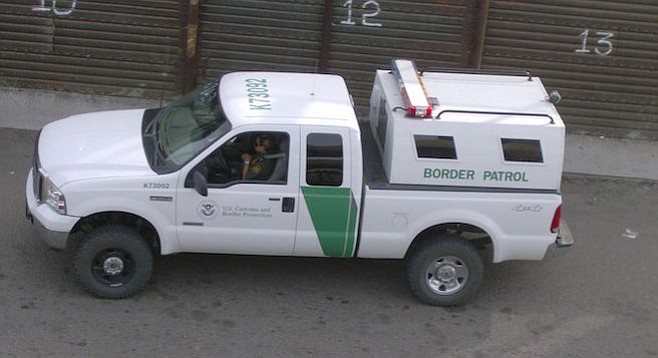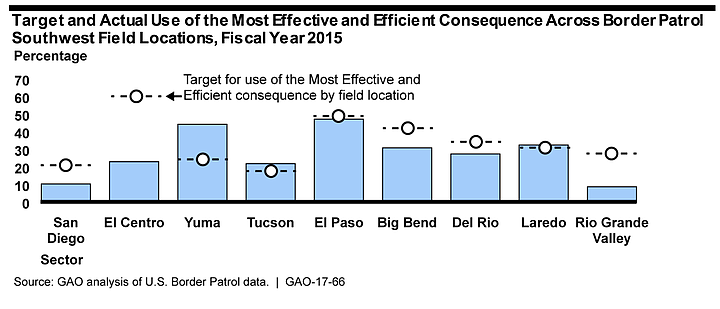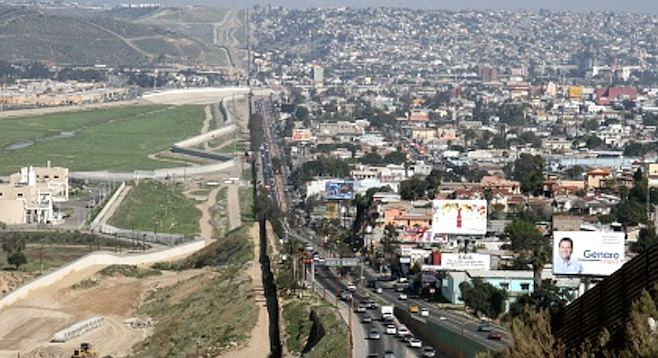 Facebook
Facebook
 X
X
 Instagram
Instagram
 TikTok
TikTok
 Youtube
Youtube

How much does it cost to deport the thousands of undocumented immigrants intercepted each year by the Border Patrol along San Diego's frontier with Mexico, and what is the true "recidivism" rate of illegal border crossers here?
It depends on how you add up the numbers, says a new performance audit critical of Border Patrol enforcement issued this month by the U.S. Government Accountability Office, entitled “Actions Needed to Improve Oversight of Post-Apprehension Consequences.”
At issue is the correct use of the government's so-called Consequence Delivery System, described as "a process that identifies consequences as Most Effective and Efficient to deter illegal cross border activity," in each of the agency’s so-called enforcement sectors.

"Officials from three of the nine southwest sectors — Del Rio, El Centro and San Diego — reported that sector management did not monitor the extent that their agents were applying the consequences defined in [the Consequence Delivery System] guides as Most or Least Effective and Efficient as of March 2016," per the January 12 document.
"Using Border Patrol’s methodology considering only recidivists within the fiscal year, the San Diego sector had the highest rate of recidivism at 26 percent in fiscal year 2015,” the audit says.
“Our alternative analysis of recidivism rates using alien apprehension history over three years (fiscal years 2013 through 2015), showed that the San Diego sector had the highest rate of recidivism at 45 percent."
On top of that, the audit says, “our analysis of sector cost estimates identified errors, variations, and omissions in how sectors estimated costs, which limited the utility of the estimates in determining which consequences are Most Effective and Efficient.”

Flawed workbooks, distributed by Washington as a means of instructing employees on how to tally costs, were blamed for the discrepancies, particularly regarding repeat violators subject to deportation under what the government calls “reinstatement of removal orders.”
“Specifically, the workbooks calculate annual housing and facility costs on a per hour basis, not a per alien basis, and thus do not properly account for the volume of aliens each sector apprehends in a given year,” according to the report.
“Border Patrol staff from the San Diego sector using the workbooks estimated a cost of about $2,366 per noncriminal alien receiving a consequence of reinstatement of a removal order for fiscal year 2015. However, once we accounted for the number of aliens apprehended in the San Diego sector — more than 25,000 aliens in fiscal year 2015 — we calculated a cost estimate of $282.”
In addition, the report says, “the housing and care cost estimates do not account for personnel time involved in housing an alien. For example, San Diego sector officials estimated that a noncriminal alien is detained for 36 hours to process a reinstatement of removal order, but estimated using six hours of personnel time, rather than 42 hours which would account for both processing and detention time.”
The resulting confusion has made it difficult to track the true cost of deportation and hence develop a rational plan to handle the problem, says the report.

“For example, five sectors included facility costs such as electricity, gas, and rent in their cost estimates for the consequence of reinstating a removal order, while three other sectors did not include any facility costs in their estimates for the same consequence. As a result, the reported cost for this consequence for a noncriminal alien ranged from $135 in Laredo sector to more than $80,000 in Rio Grande Valley sector.”
Noting that “six of nine field locations [including San Diego] missed performance targets for application of the Most Effective and Efficient consequences in fiscal year 2015,” the report in part blames “agents’ hesitation to apply consequences that require referral to federal partners facing capacity constraints, such as Department of Justice immigration courts.”
The Department of Homeland Security, which runs the Border Patrol, concurred with most of the findings, taking exception to the report’s guidance on calculating multi-year recidivism rates.
"Due to uncontrollable, external impacts to the unique consequences available to a given sector, which may change at any time, using the recidivist rate of multiple years would not benefit Border Patrol.”


How much does it cost to deport the thousands of undocumented immigrants intercepted each year by the Border Patrol along San Diego's frontier with Mexico, and what is the true "recidivism" rate of illegal border crossers here?
It depends on how you add up the numbers, says a new performance audit critical of Border Patrol enforcement issued this month by the U.S. Government Accountability Office, entitled “Actions Needed to Improve Oversight of Post-Apprehension Consequences.”
At issue is the correct use of the government's so-called Consequence Delivery System, described as "a process that identifies consequences as Most Effective and Efficient to deter illegal cross border activity," in each of the agency’s so-called enforcement sectors.

"Officials from three of the nine southwest sectors — Del Rio, El Centro and San Diego — reported that sector management did not monitor the extent that their agents were applying the consequences defined in [the Consequence Delivery System] guides as Most or Least Effective and Efficient as of March 2016," per the January 12 document.
"Using Border Patrol’s methodology considering only recidivists within the fiscal year, the San Diego sector had the highest rate of recidivism at 26 percent in fiscal year 2015,” the audit says.
“Our alternative analysis of recidivism rates using alien apprehension history over three years (fiscal years 2013 through 2015), showed that the San Diego sector had the highest rate of recidivism at 45 percent."
On top of that, the audit says, “our analysis of sector cost estimates identified errors, variations, and omissions in how sectors estimated costs, which limited the utility of the estimates in determining which consequences are Most Effective and Efficient.”

Flawed workbooks, distributed by Washington as a means of instructing employees on how to tally costs, were blamed for the discrepancies, particularly regarding repeat violators subject to deportation under what the government calls “reinstatement of removal orders.”
“Specifically, the workbooks calculate annual housing and facility costs on a per hour basis, not a per alien basis, and thus do not properly account for the volume of aliens each sector apprehends in a given year,” according to the report.
“Border Patrol staff from the San Diego sector using the workbooks estimated a cost of about $2,366 per noncriminal alien receiving a consequence of reinstatement of a removal order for fiscal year 2015. However, once we accounted for the number of aliens apprehended in the San Diego sector — more than 25,000 aliens in fiscal year 2015 — we calculated a cost estimate of $282.”
In addition, the report says, “the housing and care cost estimates do not account for personnel time involved in housing an alien. For example, San Diego sector officials estimated that a noncriminal alien is detained for 36 hours to process a reinstatement of removal order, but estimated using six hours of personnel time, rather than 42 hours which would account for both processing and detention time.”
The resulting confusion has made it difficult to track the true cost of deportation and hence develop a rational plan to handle the problem, says the report.

“For example, five sectors included facility costs such as electricity, gas, and rent in their cost estimates for the consequence of reinstating a removal order, while three other sectors did not include any facility costs in their estimates for the same consequence. As a result, the reported cost for this consequence for a noncriminal alien ranged from $135 in Laredo sector to more than $80,000 in Rio Grande Valley sector.”
Noting that “six of nine field locations [including San Diego] missed performance targets for application of the Most Effective and Efficient consequences in fiscal year 2015,” the report in part blames “agents’ hesitation to apply consequences that require referral to federal partners facing capacity constraints, such as Department of Justice immigration courts.”
The Department of Homeland Security, which runs the Border Patrol, concurred with most of the findings, taking exception to the report’s guidance on calculating multi-year recidivism rates.
"Due to uncontrollable, external impacts to the unique consequences available to a given sector, which may change at any time, using the recidivist rate of multiple years would not benefit Border Patrol.”
Comments